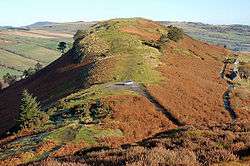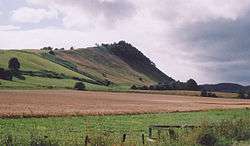Battle of Drumchatt
| Battle of Drumchatt (1497) | |||||||
|---|---|---|---|---|---|---|---|
| Part of Rebellion of Domhnall Dubh | |||||||
 Knockfarrel hill also known as the cat's back at Drumchatt where the clan battles are said to have taken place | |||||||
| |||||||
| Belligerents | |||||||
|
Clan Mackenzie Clan Munro (Loyal to James IV of Scotland) |
Clan MacDonald of Lochalsh (Loyal to Domhnall Dubh) | ||||||
| Commanders and leaders | |||||||
| Hector Roy Mackenzie of Gairloch | Alexander MacDonald of Lochalsh | ||||||
| Strength | |||||||
| Unknown | Unknown | ||||||
| Casualties and losses | |||||||
| Unknown | Unknown | ||||||
The Battle of Drumchatt was a Scottish clan battle that took place in 1497. The Clan Mackenzie and possibly the Clan Munro[note 1] defeated the Clan MacDonald of Lochalsh at Drumchatt (Druimchat) or "the Cat's Back", a ridge to the southeast of Strathpeffer.[1]
Background
In 1493, the powerful chief of the Clan Donald lost his right to the title of Lord of the Isles when it was revoked by King James IV of Scotland. As a result, many of the western and other northern clans, particularly the Clan MacLeod of Harris and Dunvegan, felt that they no longer had to pledge allegiance to the MacDonalds. Although their relatives, the Clan MacLeod of Lewis supported the rebellion of Domhnall Dubh, chief of Clan Donald.
In 1495, King James assembled an army at Glasgow. Then, on May 18, many of the highland chiefs made their submissions to him, including those of the Clan Mackenzie and Clan Munro. This may explain the unusual alliance between the Munros and Mackenzies who were rival clans. However, while the presence of the Clan Munro at the Battle of Drumchatt in 1497 is mentioned by early 19th-century historian Donald Gregory, according to late 19th-century historian Alexander Mackenzie, the Munros are not mentioned as being present in the earliest account which was written by Sir Robert Gordon in the early 17th century.[2]
Historical accounts
The Battle of Drumchatt of 1497 is recorded in several recognised historical documents including the MacDonald MS history and also in several published books, including Sir Robert Gordon's A Genealogical History of the Earldom of Sutherland (1625) and Donald Gregory's History of the Western Highlands and Isles of Scotland (1835). The battle is also recorded by historian William Anderson in his book The Scottish Nation: Or, The Surnames, Families, Literature, Honours, and Geographical History of the People of Scotland.[3]
Sir Robert Gordon (1625)
17th-century historian Sir Robert Gordon (1580–1650) writes of the skirmish at Drumchatt, as being fought after the Battle of Blar Na Pairce, which was also fought between the MacDonalds and Mackenzies:
Thereafter, some of the islanders and the Clandonald met with Clankeinzie at a place in Ross called Drumchatt, where ensued a sharp skirmish; bot in the even the ilanders wer put to the worst, and chassed out of Rosse at that tyme.[4]
Donald Gregory (1836)
From Donald Gregory's History of the Western Highlands and Isles of Scotland from AD 1493 to AD 1625, quoting Gordon. Published in 1836 and reprinted in 1996:
A.D. 1497: "The active share taken by King James in supporting the pretensions of Perkin Warbeck, withdrew his attention, for a time from the state of the Western Isles, and seems to have given opportunity for a new insurrection—which, however, was suppressed without the necessity for another Royal expedition. Sir Alexander (MacDonald) of Lochalsh — whether with the intention of claiming the earldom of Ross, or of revenging himself on the Mackenzies, for his former defeat at Blairnepark, is uncertain—invaded the more fertile districts of Ross in a hostile manner. He was encountered by the Mackenzies and Munroes at a place called Drumchatt, where, after a sharp skirmish, he and his followers were again routed and driven out of Ross."[5]
Aftermath of the battle
Donald Gregory also gives an account of the events in the aftermath of the battle, quoting from the MS histories of the Mackenzies and Mackintoshs:
After this event, the knight of Lochalsh proceeded southward among the Isles, endeavouring to rouse the Islanders to arms in his behalf, but without success owing, probably to the terror produced by the execution of Sir John of Isla and his sons. Meantime, MacIian of Ardnamurchan, judging this a proper opportunity of doing an acceptable service to the King, surprised Lochalsh in the island of Ornasay, whither he had retreated, and put him to death, In this MacIan was assisted by Alexander, the eldest surviving son of John of Isla, with whom he had contrived to effect a reconciliation, and to whom he had given his daughter in marriage.[5]
Sir Alexander of Lochalsh left both sons and daughters, who afterwards fell into the King's hands, and of whom we shall have occasion to speak in the sequel. About the same time as the unsuccessful insurrection of which we have just spoken, the chiefs of Mackenzie and MacKintosh made their escape from Edinburgh Castle; but, on their way to the Highlands, they were treacherously seized at the Torwood, by the Laird of Buchanan. Mackenzie having offered resistance, was slain, and his head, along with MacIntosh, who was taken alive, was presented to the King by Buchanan. The latter was rewarded, and MacIntosh returned to his dungeon, where he remained till after the battle of Flodden.[6]
A mythical battle at Drumchatt
| 'Mythical' Battle of Drumchatt (1501) | |||||||
|---|---|---|---|---|---|---|---|
| Part of Clan Munro and Clan Mackenzie feud | |||||||
 Knockfarrel hill also known as the cat's back at Drumchatt where the clan battles are said to have taken place | |||||||
| |||||||
| Belligerents | |||||||
| Clan Mackenzie | Clan Munro | ||||||
| Commanders and leaders | |||||||
| Hector Roy Mackenzie of Gairloch | William Munro, 12th Baron of Foulis | ||||||
| Strength | |||||||
| 140 | 700 or 900 | ||||||
| Casualties and losses | |||||||
| Unknown | Unknown | ||||||
Another account of a battle at Drumchatt published by Alexander Mackenzie in his books The History of the Mackenzies (1894) and The History of the Munroes of Fowlis (1898) describes a battle that was fought between the Munros and Mackenzies in 1501. This has perplexed many historians because there is no reference in any contemporary historical documents to such a battle. The historian Alexander Mackenzie was related to Hector Roy Mackenzie of Gairloch who he claims led the Mackenzies at this battle.[8]
Mackenzie's account states that William Munro, 12th Baron of Foulis led a group of 900 Munros, Dingwalls and MacCullochs [note 2] who attacked the Mackenzies, laying waste to their lands and taking cattle. However, on their return, they were attacked by just 140 Mackenzies, led by Hector Roy Mackenzie of Gairloch at a place called Drumchatt, where Munro's force of 900 was defeated.
Alexander Mackenzie's story seems to be based on a short verse which was written by Rev. John MacRae (d.1704) in his Ardintoul MS History of the Mackenzies. It reads:
"Did eight hundred men defeat and many kill, With his seven score on the face of Pharrel hill".
Knockfarrel is the eastern extension of the Drumchatt ridge. A score equates to 20 people and so seven score would be 140. A modern historian, C.I Fraser of Reeling also mentions William Munro and the alleged Battle of Drumchatt in 1501:[7]
William Munro of Foulis played a prominent part in public affairs in the north, and was knighted by James IV. In 1501 in some official capacity, he led a composite force of Munros, Dingwalls, and MacCullochs to attack Hector Roy Mackenzie of Gairloch at Druim-a-Chait, near Strathpeffer. Mackenzie chronicles have claimed a signal victory. Whatever the truth, the very next year the Munro Chief was commanded to proceed to Lochaber on that hazardous ploy, "the King's business". There, in 1505, he was slain by Lochiel.
Munro - Mackenzie marriage
In the early 16th century, Catherine Mackenzie the daughter of chief Kenneth Mackenzie, 7th of Kintail married chief Hector Munro, 13th Baron of Foulis. According to historian Alexander Mackenzie the marriage of the Mackenzie daughter to the Munro chief was an act of reconciliation after the Battle of Drumchatt in 1501,[9] the only account of which is given by Alexander Mackenzie and of which there is no contemporary historical evidence for.
References
- ↑ Handbook for travellers in Scotland (2nd ed.), London: John Murray, 1867
- ↑ Mackenzie, Alexander. (1898). History of the Munros of Fowlis. p. 27 - 28.
- ↑ Anderson, William. (1836). The Scottish Nation: Or the Surnames, Families, Honours, and Geographical History of the People of Scotland. p. 214.
- ↑ Gordon, Sir Robert (1580–1650), A Genealogical History of the Earldom of Sutherland. Written in 1625. Re-published in 1813: Page 77.
- 1 2 Gregory, Donald. (1835). History of the Highlands from A.D. 1493 to A.D. 1625. p. 92. Quoting: Macvurich's MS and MacDonald's MS.
- ↑ Gregory, Donald. (1835). History of the Highlands from A.D. 1493 to A.D. 1625. Quoting: the Mackenzies and MacKintoshes MS histories.
- 1 2 Fraser, C.I of Reeling. (1954). The Clan Munro. pp. 20 - 21. ISBN 0-7179-4535-9.
- ↑ Mackenzie, Alexander. (1894). History of the Mackenzies. (Original version that includes Mackenzie family tree).
- ↑ Mackenzie, Alexander. (1894). History of the Mackenzies. pp. 116 - 117.
Notes
- ↑
- The presence of the Clan Munro at the Battle of Drumchatt in 1497 is mentioned by early 19th-century historian Donald Gregory but the Munros are not mentioned as being present in the earliest account which was written by Sir Robert Gordon in the early 17th century.
- ↑
- Mackenzies book History of the Mackenzies (page 395) states that Munro's force numbered 700 at the Battle of Drumchatt of 1501. However in Mackenzie's book History of the Munro's of Fowlis (page 30) he states that Munro's force numbered 900.
Further reading
- Clan Donald. By Donald J MacDonald. Page 129. Published in 2008.
- Feuds, Forays and Rebellions: History of the Highland Clans 1475 - 1625. By John L Roberts. Published in 1999.
- Clan warfare in the Scottish Highlands. By David Norman Mackay. Page 82. Published in 1922.
- History of Scotland to the present time. By Peter Hume Brown. Page 254 - 255. Published in 1911.
- The clan Donald. By Archibald MacDonald. Page 295. Published in 1896.
External links
- The History of the Clan MacDonald Part III@ElectricScotland
- King James IV of Scotland: A Brief Survey of His Life and Times Book by R. L. Mackie; Oliver and Boyd, 1958. 302 pgs.